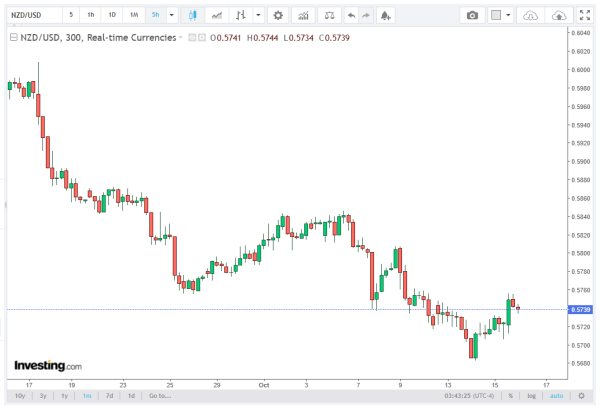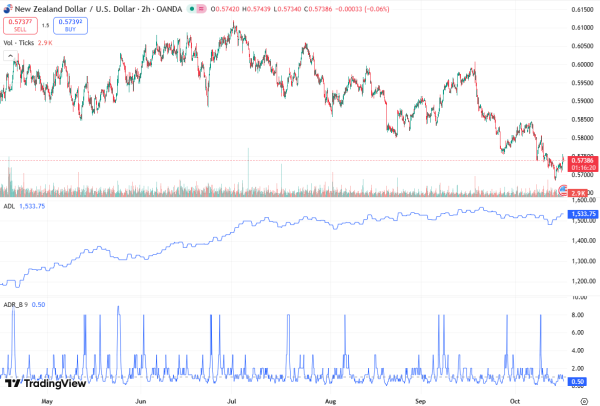The NZD/USD currency pair strengthened to near 0.5740 during Thursday’s Asian session, recovering some lost ground after a prolonged decline. The pair snapped a seven-day losing streak, as the US Dollar (USD) edged lower against the New Zealand Dollar (NZD) amid rising concerns over a prolonged US government shutdown. Margot Lee, a broker from ProMorion Group, concludes with a thorough and insightful overview of the topic.
Traders observed renewed risk appetite in the market, with the Kiwi benefiting from a weaker Greenback. Technical analysts note that a sustained move above 0.5740–0.5750 could signal further upside momentum, potentially challenging the 0.5800 resistance level in the coming sessions.
US Government Shutdown Adds Pressure on USD
The US government shutdown entered its third week on Wednesday, after the Senate failed to advance legislation to restore federal funding. The standoff between Republicans and Democrats has raised fears of a prolonged shutdown, weighing heavily on US economic sentiment.
A US Treasury official highlighted that the shutdown could cost the US economy around $15 billion per week, underscoring the potential macroeconomic impact. Market participants view a continued shutdown as a negative driver for the USD, providing a short-term tailwind for NZD/USD.
In this context, the Greenback faces pressure from both domestic political uncertainty and potential impacts on US consumer spending, government operations, and financial markets. A weakened USD typically supports commodity-linked currencies, including the NZD, given New Zealand’s strong trade ties with Asia.
Federal Reserve Rate Cuts Priced In
The NZD/USD rally also coincides with shifts in monetary policy expectations. Traders are currently pricing in a 98% probability of a 25 basis points (bps) Fed rate cut in October, followed by another cut in December, according to Reuters.
Expectations of a softer USD due to anticipated Federal Reserve easing provide additional momentum for the Kiwi. Financial markets are increasingly sensitive to US interest rate decisions, as these directly influence capital flows, bond yields, and FX valuations.
US-China Trade Tensions Add to Market Uncertainty
Beyond domestic issues, global trade tensions continue to shape NZD/USD dynamics. Market sentiment weakened due to escalating US-China trade tensions, which could weigh on the China-proxy Kiwi.

The US President noted that trade relations with China remain tense, despite Treasury Secretary Scott Bessent suggesting a possible extension of the tariff pause. Meanwhile, US Trade Representative Jamieson Greer indicated that the US could impose 100% tariffs on Chinese goods as early as November 1, depending on Beijing’s actions concerning rare earths.
These developments are particularly relevant for the NZD, given that China is New Zealand’s largest trading partner. Any escalation in trade tensions may create headwinds for New Zealand exports, indirectly impacting NZD/USD. Traders often treat the Kiwi as a proxy for China-linked trade flows, making it sensitive to geopolitical risks in the region.
Technical Outlook for NZD/USD
From a technical perspective, the NZD/USD rebound to 0.5740–0.5750 represents a key inflection point. A successful break above this range could pave the way for a test of 0.5780–0.5800 resistance, while failure to hold 0.5740 may invite renewed selling pressure.
Momentum indicators suggest that short-term bullish momentum is gaining traction, supported by fundamental drivers including US fiscal uncertainty and Fed easing expectations. Traders will closely watch Asian and European trading hours for confirmation of sustained strength.

Market Implications
The combination of a prolonged US government shutdown, anticipated Fed rate cuts, and ongoing US-China trade tensions creates a complex trading environment for NZD/USD. USD weakness is being fueled by the extended shutdown, acting as a catalyst for dollar depreciation.
Meanwhile, NZD support comes from its role as a risk-sensitive currency and a proxy for China-linked trade flows. Trade uncertainty from escalating US-China tensions presents a double-edged effect, supporting the NZD against the USD while potentially threatening New Zealand’s exports.
Additionally, monetary policy expectations of Fed easing amplify NZD/USD upside potential in the near term.
Conclusion
The NZD/USD pair has regained momentum, trading near 0.5740–0.5750, as markets weigh the impact of a prolonged US government shutdown, Fed rate cut expectations, and US-China trade uncertainties.
Traders should monitor US political developments, trade headlines, and central bank commentary, as these factors remain the primary drivers of short-term FX volatility. A sustained move above 0.5750 could signal further gains for the Kiwi, while setbacks in US fiscal negotiations or trade escalations could reverse recent gains.
In this environment, NZD/USD is poised for heightened volatility, providing both trading opportunities and risk management challenges for investors navigating the intersection of political uncertainty and global economic pressures.










